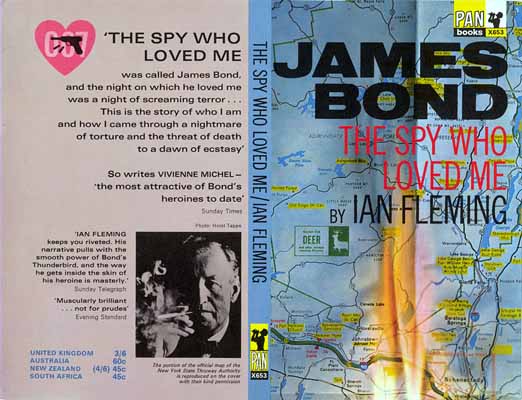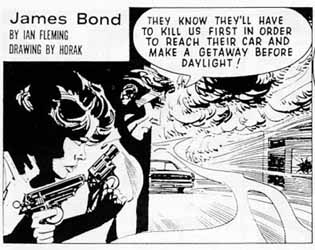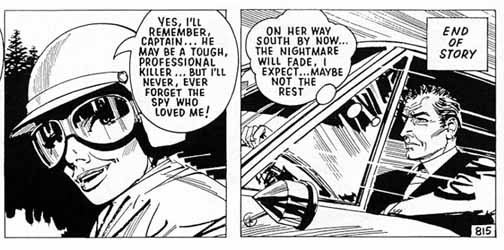|
By the time Jim Lawrence came to adapt The Spy Who Loved
Me as part of the Daily Express newspaper strip
series, SPECTRE had apparently disbanded, following the demise
of its leader Blofeld in You Only Live Twice. Lawrence
decided to introduce a revived SPECTRE, led by a mysterious
masked figure called Madame Spectra. So can this story fit
into a Bond chronology that contains both books and strips?
Richard McGinlay investigates...
The
reason why the comic strip adaptation of The Spy Who Loved
Me didn't happen until 1967-8 is because Ian Fleming,
dissatisfied with his own, rather experimental novel, forbade
the publication of a paperback edition or any kind of adaptation
during his lifetime. He also effectively wrote it out of his
continuity, by subsequently claiming, in On Her Majesty's
Secret Service, that SPECTRE had not been heard of since
the events of Thunderball.
Therefore, I believe it is preferable for The Spy Who Loved
Me (the novel and the comic strip) to take place later
in the series, before the comic strip The Harpies.
Lawrence's
narrative begins by detailing Bond's assignment against SPECTRE
in Toronto, though it is not the same mission that is described
in the book. In the comic strip, SPECTRE attempts to blackmail
a Canadian test pilot, whereas in the novel Bond claims that
the organisation was trying to assassinate a Russian defector.
While the first half of the strip is entirely new, it omits
the opening "Me" section of the book, which deals with the
early life of the heroine, Vivienne Michel.

If
you wanted to make your own "ultimate edition" of The Spy
Who Loved Me novel/strip, you could try reading alternate
bits of the Canadian section of the strip and the "Me" section
of the novel. The discrepancy of Bond's stated mission in
the book could be explained as either an inaccuracy in Vivienne's
account or Bond obscuring certain classified details. Assassinating
defectors never seemed like SPECTRE's style anyhow.
However,
if you prefer The Spy Who Loved Me to take place between
Thunderball and OHMSS, then it is possible to separate
the Canadian part of the comic strip to form a story in its
own right. This could be entitled Ghosthawk, after
the plane that the Canadian test pilot flies. In the summary
below, three-figure numbers refer to strip panel numbers.
Decimal places refer to frames within those panels. For example,
707.1 is the first frame of panel 707...
The imagined comic strip Ghosthawk could comprise panels
603-706 of Spy, followed by two final panels in the
arrangement 707.1+707.2+710.1 and 710.2+710.3+711.1. In its
new position, frame 710.1 would not now need its introductory
"AT MOUNTY HQ IN TORONTO" caption. Just out of frame of 711.1
would be the continuation speech bubble from 711.2, an additional
thought bubble: "IT WOULD SEEM THAT M HAS FORGIVEN ME", and
the concluding legend: "END OF STORY."
 |
The
separated-out Spy Who Loved Me strip could begin with
panels in the following arrangement: 708, 709, 711.3+712.1+712.2,
712.3+713.1+713.2, 713.3+707.3+714.1, 714.2+711.2+714.3. Frames
711.3 and 707.3 would not now need their introductory captions.
Frame 714.1 would need a new caption along the lines of: "MEANWHILE,
BOND IS LEAVING TORONTO ON A TRIP TO WASHINGTON FOLLOWING
THE COMPLETION OF A SUCCESSFUL MISSION" and 711.2 would now
contain Bond's speech from 714.2. The story could then continue
from panel 715 to the end of the story, 815.
Obviously,
to get the full sense of the above, you need to read the strip
itself. This has been reprinted by the lovely people at Titan
Books in graphic novel James
Bond 007: The Spy Who Loved Me, which I heartily
recommend.

Return
to

|